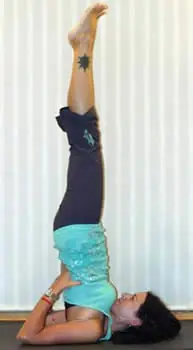Sometimes called the candle pose or Queen pose, the shoulder stand translated from the Sanskrit name is “all limbed” or “whole body.” Its name comes from the many roles it plays and benefits it provides to the entire body. It falls into each of the following categories: relaxation pose, inversion pose, gentle stretching pose and revitalizing pose.
How to: Shoulder Stand
Lay flat on the floor with your arms along side your body and your palms face-down. Bend your knees into your chest while exhaling and pressing down through your hands and arms until your toes are close to the ground behind your head. You should look as though you are in a seated forward bend—only upside down.
It’s important to position your arms under you and keep them shoulders-width apart. To do this, interlace your fingers together underneath you and shimmy the shoulders under you so you are resting on your shoulder blades to ensure proper alignment.
Now bend your elbows—keep your upper arm (shoulder to elbow) shoulders-width apart—and place your hands flat on your back. As you advance in the pose, your hands will be closer to your shoulder blades, and your legs will be straighter, stretching your hamstrings (back of the thigh). This will create an eventual 90-degree angle in your neck.
While holding the pose, concentrate on your breathing, pressing down through your upper arms and up through your legs and feet, and gently squeezing your inner thighs together. Make sure to check for symmetry, making sure legs are equal in length and the direction of your knees and feet are even and equal. If alignment is uneven, adjust accordingly. Beginners should bend knees into their foreheads and eventually work to straighten the legs out.

Benefits of Shoulder Stand
The role of the shoulder stand is important. Done properly and consistently, it has a wide range of benefits, including:
- Helps with lymph drainage
- Gets the thyroid gland functioning more efficiently--the thyroid is the gland responsible for managing your metabolism.
- Promotes good circulation to brain.
- Provides a great stretch for the neck and upper back.
- Is beneficial to people with constipation, indigestion and asthma.
- Benefits women suffering form painful menstruation.
- Increases blood flow to the brain--therefore helps headaches, congestion and sore throats
- Stretches the spine, keeping it long and strong.
- Tones the legs and abdominals.
For the lay person or yogi, the shoulder stand opens and strengthens the upper shoulder girdle and stretches the back of the neck. Since it is an inversion pose and nourishes the brain, it offers a rich supply of blood and a flood of oxygen to the organs and upper body glands. Since pressure is taken off the lower extremities, it is like super charging when you rest in this pose with your legs up. You will relieve the pressure and swelling of the feet and legs that result from tough, long days at work and play. Just getting extra blood flow to the brain, face and head will give a tired day the boost you need to continue. All this will give you the clearer head you may need to continue with long nights of studying or intense business meetings.
For the athlete, besides the aforementioned benefits, shoulder stand is a great pose of assessment. As I mentioned before, while you are holding the pose, you are in the perfect position to check leg lengths, look for imbalance, and adjust accordingly. Being aware of your leg length difference will give athletes the clues needed to realize possible low back knots or tightness. Also, stretching the neck is critical for high-contact sports like hockey and football. These athletes often find themselves in twisted predicaments, and the shoulder stand provides a great neck stretch. If the neck is supple enough to have the chin touch the chest, the risk of injury in a game is greatly reduced.
The best benefit of shoulder stands for the athlete is the reverse lymph flow. It heels the swelling of feet and legs and reduces the “heavy” post game leg. I often have my athletes hold this pose for 10 or more minutes, to help them get their quickness back. Beginners should always start with a 30-second to one-minute hold and work up to a longer time.
Although you should always consult your Physician and research a properly trained teacher before starting a yoga practice, there are a few instances where you should avoid this pose entirely, if you:
- Have thyroid disease.
- Have high blood pressure.
- Have any disorders or injuries to the neck or cervical spine.
- Have glaucoma or detached Retina-shoulder stand could worsen the condition.
Have fun exploring this pose and learning about your body.


